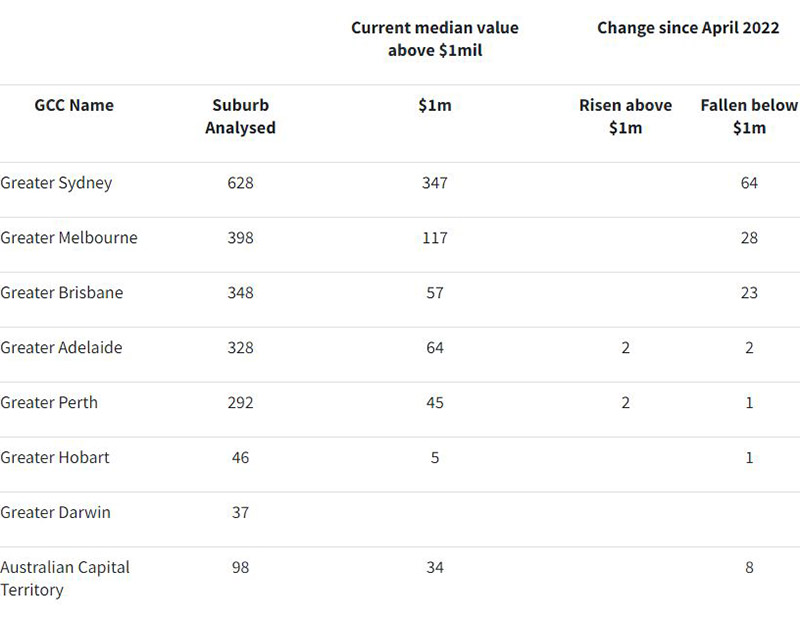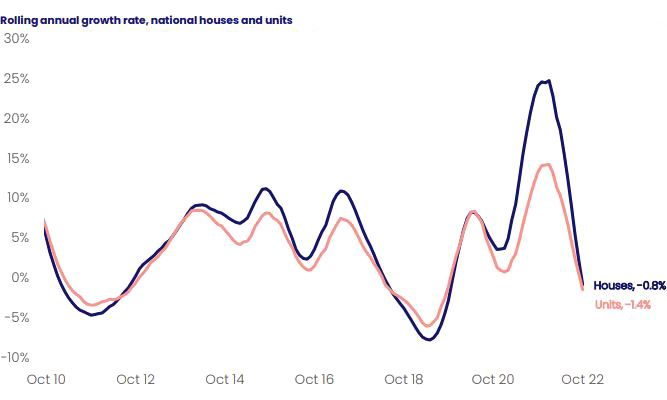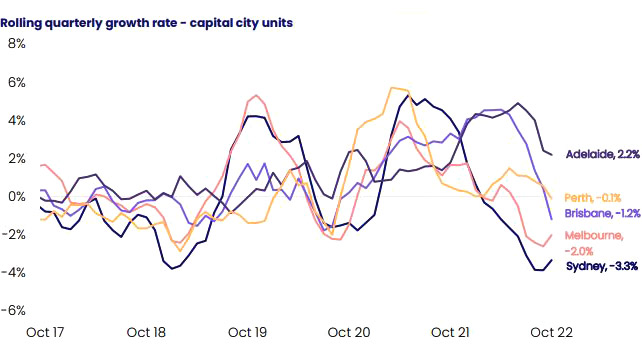From apartments to million-dollar markets, the price falls continue
There are now 169 fewer million-dollar median property price suburbs in Australia, as unit and house prices continue to fall across all price ranges even as rents continue to surge.
The fall in national property prices is having an impact on the full spectrum of the property landscape, with the slide in the more expensive markets now flowing through to relatively affordable houses and apartments.
As property affordability worsened over the past few years, buyers had flooded into the unit market but buyers and sellers alike are now sitting on the sidelines.
CoreLogic's national unit value index declined by 0.8 per cent in October, taking the median value to $598,417, 3.8 per cent below the peak recorded in April. By comparison, national house values ($779,369) fell 1.3 per cent over the month, taking house values 6.6 per cent below the April peak and 0.8 per cent lower over the 12 months to October.
The story is the same in the million-dollar markets.
Since April, the median value in 169 suburbs around the country has dropped below seven figures, while only seven suburbs across capital cities and regional areas have increased in value to $1 million or more.

Source: CoreLogic.
CoreLogic Research Director Tim Lawless said a significant proportion of more affordable outer ring suburbs in Sydney and Melbourne are no longer recording a median value of $1 million or more.
“We are seeing the more affordable housing markets recording smaller declines, but values are generally trending lower, just not as fast as more expensive areas,” he said.
“Many of these outer fringe suburbs that have fallen below the $1 million mark were previously showing median values that were only marginally over the seven-figure threshold, so in many cases, a small percentage drop in value has been enough to push values below $1 million.”
“Housing values across the most expensive quarter of the market are actually falling faster, but most of these suburbs would need to see values fall significantly further before dragging their medians below the million-dollar mark.”
Despite the decline in value, Australia still has more than double the number of suburbs with median values of $1 million or more than compared to March 2020 and the onset of COVID, when there were 393 million-dollar suburbs.
CoreLogic Economist Kaytlin Ezzy said house values continue to be more sensitive to rising interest rates compared to units.
“As the larger monthly increases in house values recorded over the final quarter of last year fall out of the annual calculation, we'll likely see the annual growth trends intersect before the performance gap between house and unit values inverts in favour of units,” she said.
As the downward phase of the cycle continues and falling values have become more widespread, the quarterly pace of decline has eased slightly.
Across the combined capitals, the quarterly change in unit values has eased from a 2.7 per cent decline in the September quarter to a 2.4 per cent dip over the three months to October.

Source: CoreLogic.
“Several factors may have helped influence this deceleration, not least the smaller increases in the official cash rate between October and November, as well as a lacklustre spring selling season,” Ms Ezzy said.
A lack of listings is helping prop prices up as sellers hold off on unloading properties while the market is in decline.
Ordinarily, advertised capital city unit listings surge by approximately 37 per cent each year between the end of winter and the spring peak in October.
But 2022 has seen a monumental shift take place.
Weaker selling conditions and lower vendor confidence saw the flow of fresh unit listings fall by 3.6 per cent over the same period. So despite the fall in buyer demand, total advertised supply has still fallen below the previous five-year average.
Sydney, Melbourne leading the way down
For buyers and sellers, the decline in the number of seven-figure suburbs simply reflects the weaker housing market conditions.
Mr Lawless said the weakness is expected to continue and with a record seventh rate rise forecast in December, it is more than likely the million-dollar club will continue to shrink.
“It is likely values will continue to trend lower across each of the broad valuation cohorts of the market, but while the upper quartile of the housing market has led the downturn, it’s also the sector of the market that is leading the easing in the pace of declines,” he said.
“The trend over the past few months has been towards an easing in the rate of decline, especially in Sydney and Melbourne, so if that trend persists, we may not see an acceleration in the number of suburbs where the median value drops below $1 million dollars.”
Of 3,649 suburbs across capital city markets, the CoreLogic report showed there are now 836 areas with a median value of $1 million or more.
Sydney and Melbourne were home to the most million-dollar markets, with 347 and 117, respectively. This was followed by Adelaide with 64, then Brisbane (57), ACT (54), Perth (45), and Hobart with five. Darwin was the only capital city without representatives in the million-dollar club.
Of the seven new million-dollar areas, Adelaide’s Forestville, in the city’s inner south-west and North Brighton, a coastal suburb, joined Burns Beach, 34km north of Perth and Alfred Cove south of the city, were the four capital city suburbs to see a rise in the median value to above $1 million since April.
Regional NSW coastal areas Emerald Beach and Bonny Hills join Bright in Victoria’s High Country as newcomers to the million-dollar club.
Rent ruled out
While many factors come into play in the causing the property market to fall, rental yields can be ruled out as a factor in the current downturn.
Renters in most parts of the country are experiencing dire vacancy shortages and increases in rent due to the lack of supply.
A flood of listings would also drive property prices down but like, rent that does not seem to be a contributor to price slides that are largely attributable to rising interest rates, together with inflation and stagnant wages that limit the ability of people to commit to property purchase expenses, such as stamp duty, deposits and insurance.

Source: CoreLogic.
Over the four weeks to the start of November, newly advertised unit listings across the combined capitals were 14.6 per cent below the previous five-year average, while total advertised supply was 8.1 per cent below the average listings level for this time of year
Vendors were not dumping unit stock or rushing to exit the market, Ms Ezzy said.
“There has been no material increase in the number of distressed unit listings, in fact, total listings have remained fairly flat, with many prospective sellers choosing to wait for more favourable market conditions rather than sell during a downturn.
“The current downturn has been fairly orderly so far, with declines first emerging in the most expensive markets before flowing through to the broad middle and more affordable markets,” Ms Ezzy said.
The quarterly pace of rental growth across the capitals has continued to trend downwards. National gross rental yields for units rose a further nine basis points in October to 4.24 per cent.
Across the individual capital city unit markets, the quarterly pace of rental growth across the capitals has continued to trend downwards. The exception was Sydney, which recorded a new cyclical peak of 4.3 per cent over the three months to October, thanks to the strong return of overseas migration.
Brisbane also recorded a 4.3 per cent quarterly rise in rental values, down from 4.6 per cent over the three months to September, while Darwin, Adelaide and Melbourne saw unit rents rise by 3.5 per cent, 3.3 per cent and 3.1 per cent, respectively.
Hobart (0.5 per cent) and Canberra (0.2 per cent) recorded milder rental growth, due partially to the stronger growth trends seen over the beginning of COVID.
“With a median weekly rental value of $510, national unit rents continue to be approximately $50 per week cheaper compared to national house rents at $561.
However, with the rate of growth in unit rents outperforming that of houses over the past year, the gap between house and unit rents has narrowed by around $10.
National unit rents are still increasing at twice the rate of house rents, up 3.3 per cent and 1.6 per cent respectively over the three months to October.
“As the affordability benefit that unit rents offer diminishes, it's possible we could see some rental demand shift back in favour of the lower density sector,” Ms Ezzy said.


















